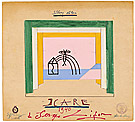Icare
Ballet in one act
- Producer: Original Ballet Russe Ltd’s Col W de Basil’s Ballet Company
- Premiere: 29 July 1940, Theatre Royal, Sydney
- Costume design: Kathleen and Florence Martin
- Costumier: Olga Larose
- Scenery design: Kathleen and Florence Martin
- Music: Robert Schumann, arranged by Antal Donati
- Choreography: Igor Schwezov
- Libretto: Igor Schwezov
- Main characters: Man, Woman, Beauty, Illusion, Truth, Will, Obsessions
The ballet is a danced allegory of humanity’s progress and struggles against the pitfalls and temptations of life. Man is distracted in turn by Illusion and Obsession. However, with the help of Beauty and Truth he finds his Will and the ballet ends with him victorious.
La Lutte éternelle is the reworking of Elkerlyc, a 1936 ballet by choreographer Igor Schwezoff, based on a fifteenth-century Dutch morality play. Schwezoff had joined de Basil’s Ballets Russes company as a dancer in 1939, and the production of La Lutte éternelle was his first for the company. Its structure, with its use of symphonic music (Schumann’s 1837 Etudes symphoniques), showed the influence of Les Présages, particularly in its theme of ‘man’s progress towards an ideal beyond worldly things’. The allegorical roles of Truth, Illusion, Beauty and Will anchored characters depicting such qualities as obsession.
The backcloth, decorated with symbolic line drawings suggesting ‘beseeching hands’, as a Sydney reviewer put it, was lit to give the illusion of a tunnel through which light streamed. Of the costumes, those for the four Obsessions were particularly striking. On one level they elaborated on a standard item of ballet costuming—the familiar long, romantic tutu, usually white, with its flowing skirt and delicate bodice. But the Martin sisters produced a startling variation on this form of costuming with their striking use of reds, golds and blacks, and in the close-fitting, long-sleeved, high-necked bodice. The skull caps with their flame-like decorative elements were perhaps modelled on headdresses such as that worn by the Rose in Le Spectre de la rose, but again the design moved in a different and bold direction.2
La Lutte éternelle received only seven performances in Australia, all in Sydney, but Schwezoff continued to stage the work for de Basil’s Ballets Russes in North and South America in the 1940s.


![Photographer unknown | Icare [Icarus] | c.1938](images/sml/32698.jpg)
![Vene BECK | Icarus falls to the ground in Icare [Icarus] | 1940](images/sml/14506.jpg)

![Vene BECK | Icarus and five male dancers in Icare [Icarus] | 1940](images/sml/32694.jpg)
![Vene BECK | Four Greek maidens in the ballet Icare [Icarus] | 1940](images/sml/32692.jpg)
![Vene BECK | Daedalus holding Icarus' wings in Icare [Icarus] | 1940](images/sml/14504.jpg)
![Vene BECK | Icarus flies in the ballet Icare [Icarus] | 1940](images/sml/14502.jpg)
![Vene BECK | The Greek maidens, one on pointe, in Icare [Icarus] | 1940](images/sml/32690.jpg)
![Vene BECK | Icarus with bow and arrow in Icare [Icarus] | 1940](images/sml/32696.jpg)

![Photographer unknown | Icare [Icarus] | 1940](images/sml/14529.jpg)